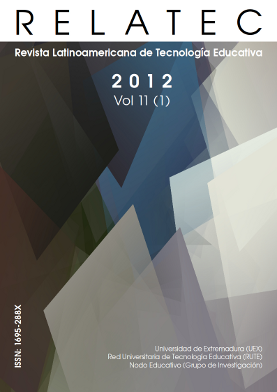Presencia de los futuros maestros en las redes sociales y perspectivas de uso educativo
Keywords:
redes sociales, aplicaciones educativas, entornos virtuales, maestros, identidad digitalAbstract
Las redes sociales se constituyen en poderosos medios de expresión, comunicación e intercambio ágil de información multiformato entre usuarios, capaces de favorecer la socialización de los mismos, y de tejer los fundamentos de comunidades de aprendizaje creativas, orientadas a impulsar la inteligencia colectiva global. Dadas sus características se convierten en recursos idóneos para ser utilizados en la enseñanza. Por ello, se consideró pertinente conocer, no sólo los usos que una muestra de 257 estudiantes universitarios de Magisterio -integrantes del presente estudio- hacen de las redes sociales sino también su consideración, en tanto futuros maestros, sobre las aplicaciones educativas que poseen, y de las utilidades que ellos mismos podrían darles en el contexto escolar. Los encuestados poseen perfil en Tuenti y Facebook. Utilizan las redes para comunicarse y relacionarse y para realizar o programar actividades académicas. La mitad dedica a esta actividad entre una y dos horas diarias, aunque cerca de la cuarta parte afirma hacerlo tres o cuatro. Desde su experiencia de usuarios avanzados, afirman rotundamente que las redes tienen un gran valor educativo, destacando las oportunidades que ofrecen para favorecer la comunicación, incrementar la socialización y el intercambio de información. Además, declaran su intención de integrarlas en su futuro desempeño profesional para la divulgación de actividades y eventos del aula o centro, para organizar y gestionar y para agilizar la comunicación entre alumnos y profesores.
Social networks are a means of expression, communication and rapid exchange of information between users Multi. Social networks encourage socialization through the basics of creative learning communities aimed at promoting global collective intelligence. Given its characteristics become resources suitable for use in teaching. Considered relevant to know not only uses 257 university students make social networks but also consideration as future teachers on educational applications they have, and utilities that they could give in the school. Students have profile on Tuenti and Facebook. Although claim to have a much wider network of contacts, 60% has more than 151 -, use networks to communicate and interact mainly with their immediate friends, and to make or academic program with their classmates. About half devoted to this activity one to two hours a day, although about a quarter said it three or four. From your experience, say that the networks have great educational value, highlighting the opportunities to improve communication, increase socialization and information exchange. Also, declare their intention to integrate them into their future professional development for the dissemination of activities and events of the classroom or center, organize and manage activities and facilitate communication between students and teachers.
Downloads
Downloads
Published
Issue
Section
License
Authors who publish in this journal accept the following conditions:
1. The Author retains copyright in the article. Upon acceptance of the article, the author shall grant to the Publisher the right of first publication of the article. with the dcoument registered with the Creative Commons Attribution-NonCommercial-NoDerivative 4.0 International (CC BY-NC-ND) license, which allows to third parties to use what is published whenever they mention the authorship of the work and the first publication in this journal.
2. Authors can make other independent and additional contractual agreements for the non-exclusive distribution of the article published in this journal (eg, include it in an institutional repository or publish it in a book) provided they clearly indicate that the work was published for the first time in this journal.
3. Authors are allowed and recommended to publish their work on the Internet (for example on institutional or personal pages) before and during the review and publication process, as it can lead to productive exchanges and a greater and faster diffusion of published work (see The Effect of Open Access).









